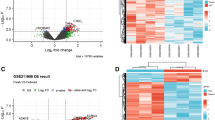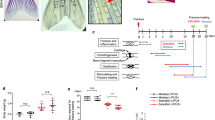Abstract
In fractures, pain signals are transmitted from the dorsal root ganglion (DRG) to the brain, and the DRG generates efferent signals to the injured bone to participate in the injury response. However, little is known about how this process occurs. We analyzed DRG transcriptome at 3, 7, 14, and 28 days after fracture. We identified the key pathways through KEGG and GO enrichment analysis. We then used IPA analysis to obtain upstream regulators and disease pathways. Finally, we compared the sequencing results with those of nerve injury to identify the unique transcriptome changes in DRG after fracture. We found that the first 14 days after fracture were the main repair response period, the 3rd day was the peak of repair activity, the 14th day was dominated by the stimulus response, and on the 28th day, the repair response had reached a plateau. ECM-receptor interaction, protein digestion and absorption, and the PI3K-Akt signaling pathway were most significantly enriched, which may be involved in repair regeneration, injury response, and pain transmission. Compared with the nerve injury model, DRG after fracture produced specific alterations related to bone repair, and the bone density function was the most widely activated bone-related function. Our results obtained some important genes and pathways in DRG after fracture, and we also summarized the main features of transcriptome function at each time point through functional annotation clustering of GO pathway, which gave us a deeper understanding of the role played by DRG in fracture.
Graphical abstract






Similar content being viewed by others
Data Availability
The datasets generated during the current study are available in the manuscript and supplementary information.
References
Nascimento AI, Mar FM, Sousa MM (2018) The intriguing nature of dorsal root ganglion neurons: linking structure with polarity and function. Prog Neurobiol 168:86–103. https://doi.org/10.1016/j.pneurobio.2018.05.002
Meltzer S, Santiago C, Sharma N, Ginty DD (2021) The cellular and molecular basis of somatosensory neuron development. Neuron 109(23):3736–3757. https://doi.org/10.1016/j.neuron.2021.09.004
Tomlinson RE, Christiansen BA, Giannone AA, Genetos DC (2020) The role of nerves in skeletal development, adaptation, and aging. Front Endocrinol (Lausanne) 11:646. https://doi.org/10.3389/fendo.2020.00646
Elefteriou F (2018) Impact of the autonomic nervous system on the skeleton. Physiol Rev 98(3):1083–1112. https://doi.org/10.1152/physrev.00014.2017
Tomlinson RE, Li Z, Li Z, Minichiello L, Riddle RC, Venkatesan A, Clemens TL (2017) NGF-TrkA signaling in sensory nerves is required for skeletal adaptation to mechanical loads in mice. Proc Natl Acad Sci U S A 114(18):E3632–e3641. https://doi.org/10.1073/pnas.1701054114
Fukuda T, Takeda S, Xu R, Ochi H, Sunamura S, Sato T, Shibata S, Yoshida Y et al (2013) Sema3A regulates bone-mass accrual through sensory innervations. Nature 497(7450):490–493. https://doi.org/10.1038/nature12115
Hill EL, Turner R, Elde R (1991) Effects of neonatal sympathectomy and capsaicin treatment on bone remodeling in rats. Neuroscience 44(3):747–755. https://doi.org/10.1016/0306-4522(91)90094-5
Basbaum AI, Bautista DM, Scherrer G, Julius D (2009) Cellular and molecular mechanisms of pain. Cell 139(2):267–284. https://doi.org/10.1016/j.cell.2009.09.028
Mach DB, Rogers SD, Sabino MC, Luger NM, Schwei MJ, Pomonis JD, Keyser CP, Clohisy DR et al (2002) Origins of skeletal pain: sensory and sympathetic innervation of the mouse femur. Neuroscience 113(1):155–166. https://doi.org/10.1016/s0306-4522(02)00165-3
Li Z, Meyers CA, Chang L, Lee S, Li Z, Tomlinson R, Hoke A, Clemens TL, James AW (2019) Fracture repair requires TrkA signaling by skeletal sensory nerves. J Clin Invest 129(12):5137–5150. https://doi.org/10.1172/jci128428
Zhang Y, Xu J, Ruan YC, Yu MK, O’Laughlin M, Wise H, Chen D, Tian L et al (2016) Implant-derived magnesium induces local neuronal production of CGRP to improve bone-fracture healing in rats. Nat Med 22(10):1160–1169. https://doi.org/10.1038/nm.4162
Berta T, Qadri Y, Tan PH, Ji RR (2017) Targeting dorsal root ganglia and primary sensory neurons for the treatment of chronic pain. Expert Opin Ther Targets 21(7):695–703. https://doi.org/10.1080/14728222.2017.1328057
Sorkin LS, Eddinger KA, Woller SA, Yaksh TL (2018) Origins of antidromic activity in sensory afferent fibers and neurogenic inflammation. Semin Immunopathol 40(3):237–247. https://doi.org/10.1007/s00281-017-0669-2
Gajda M, Litwin JA, Cichocki T, Timmermans JP, Adriaensen D (2005) Development of sensory innervation in rat tibia: co-localization of CGRP and substance P with growth-associated protein 43 (GAP-43). J Anat 207(2):135–144. https://doi.org/10.1111/j.1469-7580.2005.00434.x
Sisask G, Silfversward CJ, Bjurholm A, Nilsson O (2013) Ontogeny of sensory and autonomic nerves in the developing mouse skeleton. Auton Neurosci 177(2):237–243. https://doi.org/10.1016/j.autneu.2013.05.005
Imai S, Hukuda S, Maeda T (1994) Neonatal capsaicin pretreatment suppresses intramedullary inflammation in adjuvant-induced spondylitis. Clin Exp Immunol 95(1):108–114. https://doi.org/10.1111/j.1365-2249.1994.tb06023.x
Li J, Ahmad T, Spetea M, Ahmed M, Kreicbergs A (2001) Bone reinnervation after fracture: a study in the rat. J Bone Miner Res 16(8):1505–1510. https://doi.org/10.1359/jbmr.2001.16.8.1505
Hukkanen M, Konttinen YT, Santavirta S, Paavolainen P, Gu XH, Terenghi G, Polak JM (1993) Rapid proliferation of calcitonin gene-related peptide-immunoreactive nerves during healing of rat tibial fracture suggests neural involvement in bone growth and remodelling. Neuroscience 54(4):969–979. https://doi.org/10.1016/0306-4522(93)90588-7
Plantman S, Zelano J, Novikova LN, Novikov LN, Cullheim S (2013) Neuronal myosin-X is upregulated after peripheral nerve injury and mediates laminin-induced growth of neurites. Mol Cell Neurosci 56:96–101. https://doi.org/10.1016/j.mcn.2013.04.001
Jang DG, Sim HJ, Song EK, Kwon T, Park TJ (2020) Extracellular matrixes and neuroinflammation. BMB Rep 53(10):491–499
Pekny M, Wilhelmsson U, Pekna M (2014) The dual role of astrocyte activation and reactive gliosis. Neurosci Lett 565:30–38. https://doi.org/10.1016/j.neulet.2013.12.071
Colombo E, Farina C (2016) Astrocytes: key regulators of neuroinflammation. Trends Immunol 37(9):608–620. https://doi.org/10.1016/j.it.2016.06.006
Salhotra A, Shah HN, Levi B, Longaker MT (2020) Mechanisms of bone development and repair. Nat Rev Mol Cell Biol 21(11):696–711. https://doi.org/10.1038/s41580-020-00279-w
Liu Y, Zhang S, Xue J, Wei Z, Ao P, Shen B, Ding L (2019) CGRP reduces apoptosis of DRG cells induced by high-glucose oidative stress injury through PI3K/AKT induction of heme oxygenase-1 and Nrf-2 expression. Oxid Med Cell Longev 2019:2053149. https://doi.org/10.1155/2019/2053149
Zhang M, Shi X, Luo M, Lan Q, Ullah H, Zhang C, Li S, Chen X, Wang Y, Piao F (2021) Taurine ameliorates axonal damage in sciatic nerve of diabetic rats and high glucose exposed DRG neuron by PI3K/Akt/mTOR-dependent pathway. Amino Acids 53(3):395–406. https://doi.org/10.1007/s00726-021-02957-1
Chen L, Gong HY, Xu L (2018) PVT1 protects diabetic peripheral neuropathy via PI3K/AKT pathway. Eur Rev Med Pharmacol Sci 22(20):6905–6911. https://doi.org/10.26355/eurrev_201810_16160
Pezet S, McMahon SB (2006) Neurotrophins: mediators and modulators of pain. Annu Rev Neurosci 29:507–538. https://doi.org/10.1146/annurev.neuro.29.051605.112929
Bogen O, Joseph EK, Chen X, Levine JD (2008) GDNF hyperalgesia is mediated by PLCgamma, MAPK/ERK, PI3K, CDK5 and Src family kinase signaling and dependent on the IB4-binding protein versican. Eur J Neurosci 28(1):12–19. https://doi.org/10.1111/j.1460-9568.2008.06308.x
Sun RQ, Tu YJ, Yan JY, Willis WD (2006) Activation of protein kinase B/Akt signaling pathway contributes to mechanical hypersensitivity induced by capsaicin. Pain 120(1-2):86–96. https://doi.org/10.1016/j.pain.2005.10.017
Gosselin RD, Varela C, Banisadr G, Mechighel P, Rostene W, Kitabgi P, Melik-Parsadaniantz S (2005) Constitutive expression of CCR2 chemokine receptor and inhibition by MCP-1/CCL2 of GABA-induced currents in spinal cord neurones. J Neurochem 95(4):1023–1034. https://doi.org/10.1111/j.1471-4159.2005.03431.x
Hermenean A, Oatis D, Herman H, Ciceu A, D'Amico G, Trotta MC (2022) Galectin 1-a key player between tissue repair and fibrosis. Int J Mol Sci 23(10). https://doi.org/10.3390/ijms23105548
Duque G, Huang DC, Dion N, Macoritto M, Rivas D, Li W, Yang XF, Li J, Lian J, Marino FT, Barralet J, Lascau V, Deschênes C, Ste-Marie LG, Kremer R (2011) Interferon-γ plays a role in bone formation in vivo and rescues osteoporosis in ovariectomized mice. J Bone Miner Res 26(7):1472–1483. https://doi.org/10.1002/jbmr.350
Gao Y, Grassi F, Ryan MR, Terauchi M, Page K, Yang X, Weitzmann MN, Pacifici R (2007) IFN-gamma stimulates osteoclast formation and bone loss in vivo via antigen-driven T cell activation. J Clin Invest 117(1):122–132. https://doi.org/10.1172/jci30074
Hirbe AC, Uluçkan O, Morgan EA, Eagleton MC, Prior JL, Piwnica-Worms D, Trinkaus K, Apicelli A, Weilbaecher K (2007) Granulocyte colony-stimulating factor enhances bone tumor growth in mice in an osteoclast-dependent manner. Blood 109(8):3424–3431. https://doi.org/10.1182/blood-2006-09-048686
Kalinski AL, Yoon C, Huffman LD, Duncker PC, Kohen R, Passino R, Hafner H, Johnson C et al (2020) Analysis of the immune response to sciatic nerve injury identifies efferocytosis as a key mechanism of nerve debridement. Elife 9. https://doi.org/10.7554/eLife.60223
Jimi E, Ghosh S (2005) Role of nuclear factor-kappaB in the immune system and bone. Immunol Rev 208:80–87. https://doi.org/10.1111/j.0105-2896.2005.00329.x
Park BK, Zhang H, Zeng Q, Dai J, Keller ET, Giordano T, Gu K, Shah V et al (2007) NF-kappaB in breast cancer cells promotes osteolytic bone metastasis by inducing osteoclastogenesis via GM-CSF. Nat Med 13(1):62–69. https://doi.org/10.1038/nm1519
Hou X, Tian F (2022) STAT3-mediated osteogenesis and osteoclastogenesis in osteoporosis. Cell Commun Signal 20(1):112. https://doi.org/10.1186/s12964-022-00924-1
Zhou S, Dai Q, Huang X, Jin A, Yang Y, Gong X, Xu H, Gao X, Jiang L (2021) STAT3 is critical for skeletal development and bone homeostasis by regulating osteogenesis. Nat Commun 12(1):6891. https://doi.org/10.1038/s41467-021-27273-w
Sun G, Wang Z, Ti Y, Wang Y, Wang J, Zhao J, Qian H (2017) STAT3 promotes bone fracture healing by enhancing the FOXP3 expression and the suppressive function of regulatory T cells. Apmis 125(8):752–760. https://doi.org/10.1111/apm.12706
Niemi JP, DeFrancesco-Lisowitz A, Cregg JM, Howarth M, Zigmond RE (2016) Overexpression of the monocyte chemokine CCL2 in dorsal root ganglion neurons causes a conditioning-like increase in neurite outgrowth and does so via a STAT3 dependent mechanism. Exp Neurol 275:25–37. https://doi.org/10.1016/j.expneurol.2015.09.018
Hwang J, Namgung U (2020) Cdk5 phosphorylation of STAT3 in dorsal root ganglion neurons is involved in promoting axonal regeneration after peripheral nerve injury. Int Neurourol J 24(Suppl 1):S19–S27. https://doi.org/10.5213/inj.2040158.080
Zebboudj AF, Shin V, Boström K (2003) Matrix GLA protein and BMP-2 regulate osteoinduction in calcifying vascular cells. J Cell Biochem 90(4):756–765. https://doi.org/10.1002/jcb.10669
Luo G, Ducy P, McKee MD, Pinero GJ, Loyer E, Behringer RR, Karsenty G (1997) Spontaneous calcification of arteries and cartilage in mice lacking matrix GLA protein. Nature 386(6620):78–81. https://doi.org/10.1038/386078a0
Zhou X, Zhang Z, Feng JQ, Dusevich VM, Sinha K, Zhang H, Darnay BG, de Crombrugghe B (2010) Multiple functions of Osterix are required for bone growth and homeostasis in postnatal mice. Proc Natl Acad Sci U S A 107(29):12919–12924. https://doi.org/10.1073/pnas.0912855107
Castro-Mollo M, Gera S, Ruiz-Martinez M, Feola M, Gumerova A, Planoutene M, Clementelli C, Sangkhae V et al (2021) The hepcidin regulator erythroferrone is a new member of the erythropoiesis-iron-bone circuitry. Elife 10. https://doi.org/10.7554/eLife.68217
Ashley JW, Shi Z, Zhao H, Li X, Kesterson RA, Feng X (2011) Genetic ablation of CD68 results in mice with increased bone and dysfunctional osteoclasts. PLoS One 6(10):e25838. https://doi.org/10.1371/journal.pone.0025838
Funding
This work was supported by the grants from National Natural Science Foundation of China (82072162 to X.Y. and 81971177 to B.J.), and Natural Science Foundation of Beijing, China (7192215 to X.Y.).
Author information
Authors and Affiliations
Contributions
X.Y. designed the study. S.Y. processed the data and plotted the figures. X.G. and C.H. instructed all experiments and drafted the manuscript. S.W., J.D., S.G. A.S., and Q.L. analyzed the data. W.G. contributed to the investigation, methodology, and edition of the manuscript.
Corresponding authors
Ethics declarations
Ethics Approval
This study was performed in line with the animal ethics requirements of Peking University People’s Hospital (2020PHC015).
Consent to Participate
Not applicable.
Consent for Publication
Not applicable.
Competing Interests
The authors declare no competing interests.
Additional information
Publisher’s Note
Springer Nature remains neutral with regard to jurisdictional claims in published maps and institutional affiliations.
Supplementary information
ESM 1
(XLSX 2931 kb)
Rights and permissions
Springer Nature or its licensor (e.g. a society or other partner) holds exclusive rights to this article under a publishing agreement with the author(s) or other rightsholder(s); author self-archiving of the accepted manuscript version of this article is solely governed by the terms of such publishing agreement and applicable law.
About this article
Cite this article
Gu, X., Huang, C., Wang, S. et al. Transcriptomic Analysis of the Rat Dorsal Root Ganglion After Fracture. Mol Neurobiol 61, 1467–1478 (2024). https://doi.org/10.1007/s12035-023-03637-9
Received:
Accepted:
Published:
Issue Date:
DOI: https://doi.org/10.1007/s12035-023-03637-9




